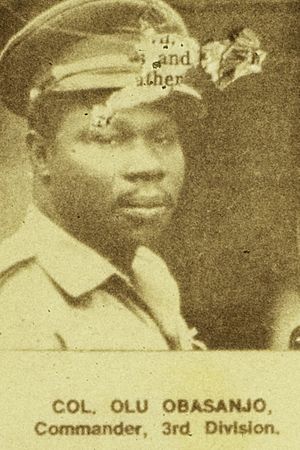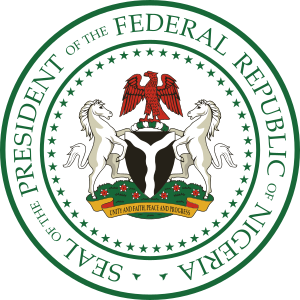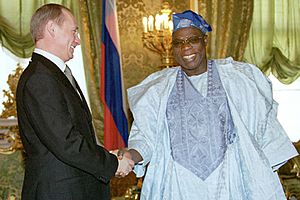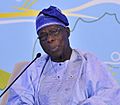Olusegun Obasanjo facts for kids
Quick facts for kids
Olusegun Obasanjo
|
|||||||||||||||||||||
|---|---|---|---|---|---|---|---|---|---|---|---|---|---|---|---|---|---|---|---|---|---|
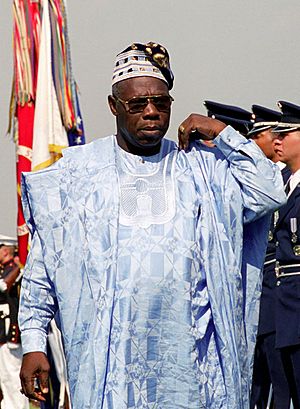
Obasanjo in 2001
|
|||||||||||||||||||||
| 5th and 12th President of Nigeria | |||||||||||||||||||||
| In office 29 May 1999 – 29 May 2007 |
|||||||||||||||||||||
| Vice President | Atiku Abubakar | ||||||||||||||||||||
| Preceded by | Abdulsalami Abubakar | ||||||||||||||||||||
| Succeeded by | Umaru Musa Yar'Adua | ||||||||||||||||||||
| In office 13 February 1976 – 1 October 1979 as Military Head of State of Nigeria |
|||||||||||||||||||||
| Chief of Staff | Shehu Musa Yar'Adua | ||||||||||||||||||||
| Preceded by | Murtala Muhammed | ||||||||||||||||||||
| Succeeded by | Shehu Shagari | ||||||||||||||||||||
| 3rd Chief of Staff, Supreme Headquarters | |||||||||||||||||||||
| In office 29 July 1975 – 13 February 1976 |
|||||||||||||||||||||
| Head of State | Murtala Muhammed | ||||||||||||||||||||
| Preceded by | J. E. A. Wey | ||||||||||||||||||||
| Succeeded by | Shehu Musa Yar'Adua | ||||||||||||||||||||
| Federal Minister of Defence | |||||||||||||||||||||
| In office 1976–1979 |
|||||||||||||||||||||
| Head of State | Himself | ||||||||||||||||||||
| Preceded by | Illiya Bisalla | ||||||||||||||||||||
| Succeeded by | Iya Abubakar | ||||||||||||||||||||
|
|||||||||||||||||||||
| Personal details | |||||||||||||||||||||
| Born |
Olusegun Matthew Okikiola Aremu Obasanjo
c. 5 March 1937 (official date of birth) Ibogun-Olaogun, Ifo, Southern Region, British Nigeria (now Ibogun-Olaogun, Ogun State, Nigeria) |
||||||||||||||||||||
| Political party | Peoples Democratic Party (1998–2015; 2018–present) |
||||||||||||||||||||
| Spouses |
Esther Oluremi
(m. 1963; div. 1976)
Stella Abebe
(m. 1976; died 2005)Mojisola Adekunle
(m. 1991; div. 1998) |
||||||||||||||||||||
| Children | Iyabo Obasanjo-Bello | ||||||||||||||||||||
| Alma mater |
|
||||||||||||||||||||
| Occupation |
|
||||||||||||||||||||
| Nicknames |
|
||||||||||||||||||||
| Military service | |||||||||||||||||||||
| Allegiance | |||||||||||||||||||||
| Branch | |||||||||||||||||||||
| Service years | 1958–1979 | ||||||||||||||||||||
| Rank | General | ||||||||||||||||||||
| Conflicts |
|
||||||||||||||||||||
Chief Olusegun Obasanjo (born around March 5, 1937) is a Nigerian politician, statesman, and former army general. He was a very important leader in Nigeria's history. He served as Nigeria's military leader from 1976 to 1979. Later, he was elected president and served from 1999 to 2007. He believes strongly in a united Nigeria.
Obasanjo was born in a small village to a farming family. He was part of the Yoruba ethnic group. He went to school in the city of Abeokuta. After school, he joined the Nigerian Army and became an engineer. He served in the Congo, Britain, and India, and became a Major.
During the Nigerian Civil War in the late 1960s, he played a key role. He helped end the war by accepting the surrender of the Biafran forces in 1970. In 1975, a military group took control of the government, and Obasanjo was one of its three main leaders. When the head of this group, Murtala Muhammed, was killed in 1976, Obasanjo became the Head of State.
As leader, he continued many of Murtala's policies. He cut government spending and made sure more children could go to school for free. He also worked to restore democracy. In 1979, he handed over power to a newly elected civilian president, Shehu Shagari. This was a very important moment for Nigeria. After this, Obasanjo retired and became a farmer.
In 1993, another military leader named Sani Abacha took power. Obasanjo spoke out against Abacha's government. In 1995, he was arrested for being part of a plan to overthrow the government, though he said he was innocent. He was released from prison in 1998 after Abacha's death.
After his release, Obasanjo decided to run for president. He won the 1999 election. As president, he worked to reduce the military's role in politics. He also worked to stop violence in different parts of the country. He was re-elected in 2003. He was a strong supporter of the African Union, an organization that helps African countries work together.
Obasanjo is seen as one of the most important African leaders of his time. He is praised for helping Nigeria become a democracy in the 1970s and for his work to promote peace in Africa.
Contents
Early Life and Education
Olusegun Obasanjo was born in the village of Ibogun-Olaogun in southwest Nigeria. His family were farmers from the Owu branch of the Yoruba people. He was the first of nine children, but only he and his sister survived childhood.
His father was a farmer, and Obasanjo helped with farm work until he was 11. At that age, he started primary school. In 1952, he went to the Baptist Boys' High School. He was a good student and a keen Boy Scout.
His family faced hard times, and Obasanjo had to work to pay for his school fees. He worked on farms, fished, and sold sand to builders. In 1956, he borrowed money to take his final school exams. After leaving school, he moved to Ibadan and worked as a teacher. He wanted to go to university but could not afford it. So, in 1958, he decided to join the Nigerian Army to become an officer.
Military Career
Training and Early Service
In 1958, Obasanjo joined the Nigerian Army. He saw it as a way to get an education and a salary. He was sent to a training school in Ghana. Then, he went for more training in Aldershot, England. He did not enjoy his time in England but did well in his studies.
He returned to Nigeria in 1959 and was stationed in Kaduna. In 1960, Nigeria became an independent country. Soon after, his army unit was sent to the Congo as part of a United Nations peacekeeping force. This experience made him a strong believer in Pan-Africanism, the idea that African countries should work together.
After returning from the Congo, Obasanjo was transferred to the Army Engineering Corps. He continued to rise through the ranks and became a major in 1965. He also studied in India at the Defence Services Staff College.
Nigerian Civil War
In 1966, there were two military takeovers, known as coups, in Nigeria. These events created a lot of tension in the country. In 1967, the southeastern region, mostly home to the Igbo people, declared independence as the Republic of Biafra. This started the Nigerian Civil War.
Obasanjo was appointed to command a division of the Nigerian Army. In May 1969, he took charge of the 3rd Marine Commando Division. He was a brave leader and was even wounded in battle. His leadership helped the Nigerian army make important gains.
In January 1970, he launched a final attack called Operation Tail-Wind. This led to the surrender of the Biafran forces. Obasanjo accepted the surrender and worked to make sure the defeated people were treated with respect. He helped to rebuild the war-torn region, which earned him the status of a war hero.
Military Head of State (1976–1979)
In July 1975, General Yakubu Gowon's government was overthrown in a peaceful coup. A new government was formed, led by three generals: Murtala Muhammed, Obasanjo, and Theophilus Danjuma. Obasanjo was the second-in-command.
In February 1976, Murtala was killed during another coup attempt. The attempt failed, and the Supreme Military Council appointed Obasanjo as the new Head of State. He promised to continue Murtala's policies.
Domestic Policies
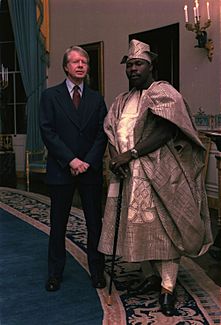
As leader, Obasanjo focused on several key areas:
- Education: He continued the push for free primary education for all Nigerian children. School enrollment grew from 6 million to 12.5 million during his rule.
- Economy: Nigeria's economy was struggling with high inflation. Obasanjo's government introduced measures to cut spending and control prices.
- Agriculture: He launched "Operation Feed the Nation" to encourage farming and reduce the need to import food.
- New Capital: His government continued the plan to move Nigeria's capital from Lagos to a more central location, Abuja.
Foreign Policy
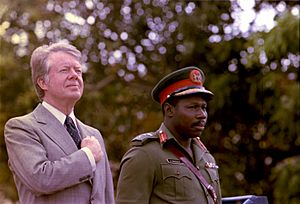
Obasanjo wanted Nigeria to be a leader in Africa. He strongly opposed the system of apartheid (racial segregation) in South Africa and white minority rule in other parts of southern Africa.
- He supported groups fighting against these governments.
- Nigeria played a key role in pressuring South Africa. For example, Nigeria led a boycott of the 1976 Summer Olympics because New Zealand's sports teams had ties with South Africa.
- He developed a close relationship with U.S. President Jimmy Carter, who also supported majority rule in Africa.
Return to Democracy
One of Obasanjo's most important achievements was returning Nigeria to a democratic government. He oversaw the writing of a new constitution. This constitution created a system similar to that of the United States, with an elected president.
Elections were held in 1979. Shehu Shagari won the presidential election. On October 1, 1979, Obasanjo peacefully handed over power to Shagari. This made him the first military ruler in Nigeria to voluntarily step down for a democratically elected government.
Life After Leaving Office
After leaving power, Obasanjo retired to his farm in Ota. He became a successful farmer, focusing on poultry. He also wrote several books about his experiences.
He remained active in international affairs. He was part of many groups working for peace and disarmament around the world. He was a co-chairman of a Commonwealth group that worked to end apartheid in South Africa. In 1986, he met with the anti-apartheid leader Nelson Mandela while Mandela was still in prison.
In 1993, General Sani Abacha took power in Nigeria. Obasanjo was a vocal critic of Abacha's harsh rule. In 1995, he was arrested and accused of plotting against Abacha. He was sentenced to prison, even though many people believed he was innocent. World leaders like Nelson Mandela and Pope John Paul II called for his release.
Abacha died in 1998, and Obasanjo was freed from prison.
Presidency (1999–2007)
After his release, friends and supporters encouraged Obasanjo to run for president. He agreed and became the candidate for the Peoples Democratic Party (PDP). He won the 1999 election.
First Term (1999–2003)
As president, Obasanjo faced many challenges. The country was divided by ethnic and religious tensions, and the economy was weak.
- Military Reform: He retired many senior military officers to prevent future coups.
- Economy: His government worked to improve the economy. He secured debt relief for Nigeria, which cancelled a large part of the country's foreign debt. He also created commissions to fight corruption.
- Niger Delta: He created the Niger Delta Development Commission to address problems in the oil-rich region.
Second Term (2003–2007)
Obasanjo was re-elected in 2003. He continued his economic reforms and his work in foreign policy.
- African Leadership: He was a key figure in the creation of the African Union. He served as its chairperson from 2004 to 2006.
- Peacekeeping: He sent Nigerian troops on peacekeeping missions to Liberia and Sierra Leone.
- Third Term Controversy: Towards the end of his second term, there was a plan to change the constitution to allow him to run for a third term. This was very controversial and was ultimately rejected by the National Assembly.
Obasanjo stepped down in 2007, respecting the constitution's term limits. He handed over power to the newly elected president, Umaru Musa Yar'Adua.
Post-Presidency
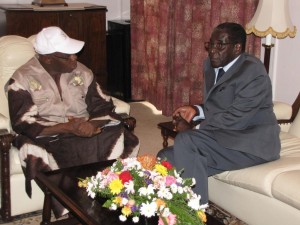
Even after leaving office, Obasanjo has remained an influential figure in Nigeria and Africa.
- Diplomacy: He has worked as a diplomat for the United Nations and the African Union. He has helped to mediate conflicts in countries like the Democratic Republic of the Congo and Ethiopia.
- Politics: He has continued to comment on Nigerian politics, often writing open letters to sitting presidents.
- Education: In 2017, at the age of 80, he earned a PhD in theology from the National Open University of Nigeria.
Obasanjo is a complex figure who has played a central role in Nigeria's history for over 50 years. He is respected for his commitment to a united Nigeria and his contributions to peace and democracy in Africa.
Images for kids
-
The 1979 election of Margaret Thatcher as British Prime Minister contributed to deteriorating UK-Nigerian relations.
-
In 1986, Obasanjo met with Nelson Mandela. He said it "was an encounter never to be forgotten."
-
Obasanjo with the Iranian President Mohammad Khatami in 1999
-
Obasanjo with Donald Rumsfeld at The Pentagon in 2001
-
Bush talks with Obasanjo during a G8 Summit in France, June 2003
-
Olusẹgun Obasanjo and the President of Brazil, Lula da Silva, 2005
-
Obasanjo with George W. Bush in March 2006
-
US Secretary of State Antony Blinken meets with Obasanjo in October 2021
-
Obasanjo speaking at the African Development Bank Group annual meeting in Kigali in 2014
See also
 In Spanish: Olusegun Obasanjo para niños
In Spanish: Olusegun Obasanjo para niños
- Olusegun Obasanjo Presidential Library


